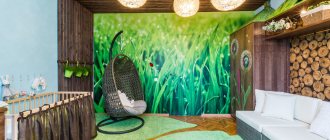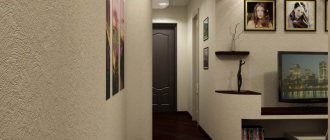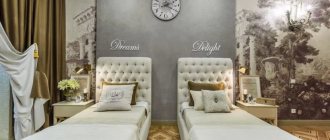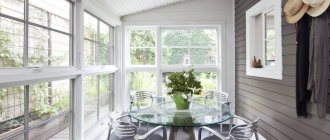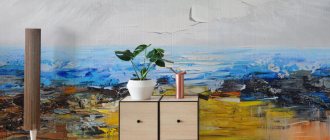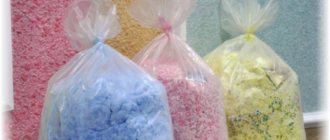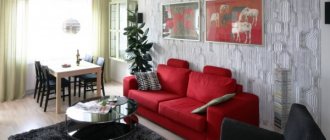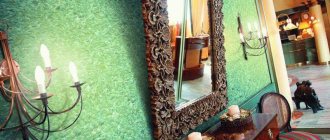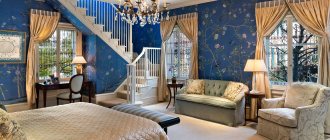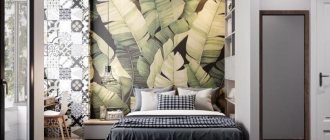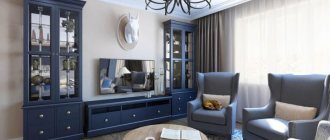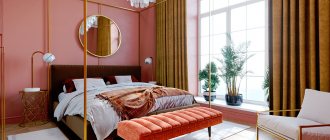What is this?
Self-adhesive wallpaper is a decorative finishing coating that has an adhesive base that is protected by film. People call it self-adhesive film. This finishing method allows you to avoid unnecessary costs for glue and carry out repairs yourself. Self-adhesive wallpaper is suitable not only for walls, but also for decorating objects and other surfaces.
Characteristics and Features
Self-adhesive wallpaper has a convenient protective film, which greatly simplifies the work and saves money on additional expenses. Before gluing it is simply removed. The coating is produced in different sizes, the width of the roll starts from 40 cm and can reach a meter. The length is usually standard 15 meters.
A positive feature of PVC coating is its good interaction with moisture, suitable for finishing a kitchen or toilet; the surface can be wiped with a damp cloth.
Preparing the premises
Before starting repairs, it is recommended to remove all equipment from the premises and dismantle sockets and switches. The floor, as well as all large objects that are difficult to carry or simply could not be removed, must be covered with dense material. A regular blanket or film is perfect for these purposes.
If there is such a need, it is better to level the walls before repairing. To do this, you can use a leveling solution or special paper. Fortunately, such materials are sold in any hardware store.
It won't hurt to treat the wall with a primer mixture. After all, this will not only increase the chances that the wallpaper will stick securely to the wall, but will also protect apartment owners from the appearance of fungus or other parasites.
If the apartment owners have started renovations for the first time, before starting work you need to obtain instructions that will facilitate and speed up the gluing process. It is necessary to prepare all the tools, a special suit and gloves in advance.
When hanging wallpaper at home, it would be useful to have the help of a second person. This will make the gluing process twice as fast. How to do this work correctly? Below we will look at the step-by-step instructions.
Advantages and disadvantages
Self-adhesive wallpaper has many advantages over other types, but it is worth paying attention to some of the disadvantages of the coating.
| pros | Minuses |
| Can be used in the bathroom and kitchen due to the high moisture resistance of the material | Unevenness and defects in the walls will be noticeable on the PVC coating, so the surface must be fairly smooth and even. |
| Long service life | Some types of self-adhesive wallpaper are expensive |
| Quick and easy interior renovation that even beginners can do | |
| Wide range of models | |
| Easy to keep in order, can be wet cleaned | |
| There is no smell of glue, no need to ventilate the room after the wallpaper has dried |
The photo shows an example of how to quickly decorate a headboard with self-adhesive tape.
No. 2. Advantages and disadvantages
The main advantage of the material is its simple and quick installation process . Self-adhesive wallpaper has other advantages :
- moisture resistance , so the material is suitable for finishing walls in bathrooms and kitchens. However, experts do not recommend covering “cold” walls with it, since condensation may begin to accumulate under the film, which will gradually lead to the formation of mold and mildew;
- resistance to ultraviolet rays, long preservation of original colors;
- resistance to high (up to +800C) and low temperatures (-400C);
- strength and durability , wear resistance;
- harmless to health. There are no toxic fumes either during installation or during operation;
- a huge variety of patterns and textures . You can find wallpapers that look like wood and stone, with floral prints, intricate fantasy patterns, and with a matte or glossy surface. There are even wallpapers with photo printing, better known as self-adhesive photo wallpapers - in general, there is plenty to choose from;
- versatility , wide scope of application. Self-adhesive (as self-adhesive wallpaper is called) is used for wall decoration, quick change of decor, restoration or modernization of furniture, for pasting door panels and other purposes;
- the low cost of the material only encourages experimentation.
downsides as such. You just have to keep in mind that the material is quite thin and will reveal all the surface irregularities , so the walls must be smooth or with minimal defects - there will be no concessions. Self-adhesive wallpaper made on the basis of polyvinyl chloride , although they have the best performance qualities, have a significant disadvantage - they do not allow air to pass through . If part of the wall is lined with such material, then nothing bad will happen, but if all the walls are covered, then it will be necessary to take care of reliable ventilation.
Classification
All self-adhesive wallpaper can be divided into categories based on material, number of layers and type of design.
The main components in different wallpapers are: polyvinyl chloride, synthetic fiber, propylene, which are supplemented with stabilizers and plasticizers. Color and texture are provided by dyes and artificial fibers of the fabric.
Types by number of layers
Self-adhesive wallpaper is distinguished by the number of layers.
- Single layer. Single-layer self-adhesive wallpaper, otherwise known as PVC film, has a complex multi-component composition, including PVC resin, plasticizers, stabilizers and pigments. All components combine and form a homogeneous mass. After which the process of transformation directly into film takes place through heat treatment or extrusion. The result is a self-adhesive, moisture-proof film.
- Double layer. Double-layer self-adhesive wallpaper consists of a base and a top layer. Paper and fabric are most often used as a base. The top layer has a complex composition based on polyvinyl chloride resin. The resulting material is inferior in technical characteristics to single-layer PVC film, but is more flexible and easier to work with.
Types by material
In all types, the base is an adhesive layer, but the decorative part, that is, the top coating, can be different.
Vinyl
Durable and washable self-adhesive fabric is available in stores in a variety of colors. The production features almost completely deprive the material of the ability to pass air, so in a room with high humidity it is worth taking care of ventilation. The advantages of the coating include low cost.
Paper
Paper is an environmentally friendly and inexpensive material, but, unfortunately, it does not have high technical characteristics. The coating fades in the sun, is not resistant to moisture and has low wear resistance.
Cork
Cork self-adhesive coating has an absolutely natural composition and is made directly from cork wood, which means it is safe for all residents of the house. The material is hypoallergenic, has good sound insulation properties and retains heat.
To decorate the kitchen, you should choose a canvas coated with wax; it protects against the absorption of odors, increases its service life and simplifies the cleaning process. Self-adhesive cork wallpaper will be a good solution for decorating a child's room; you can use it to create a whole shaped composition.
Fabric
In other words, satin self-adhesive wallpaper has a dense fabric base. Externally, the coating is matte, reminiscent of fabric. The material has high strength indicators and hides minor wall defects.
Types by type of coating
Matte
The surface has a velvety appearance, the walls do not reflect light or glare, and the interior is very soft. The matte self-adhesive coating is suitable for modern and classic designs. Drops of water and stains are invisible on them.
Glossy
Glossy self-adhesive wallpaper will help make the room brighter and lighter due to the reflective properties of the film. This finish is suitable for decorating a room with poor lighting. The coating requires careful care, as settling dust and drops of water will be visible on the shiny surface.
Cretaceous
A great idea for decorating the interior of a children's room, hallway or kitchen. Otherwise, chalk self-adhesive wallpaper can be called a painting surface; visually it resembles a black slate board. You can draw on the surface with crayons and then erase it. For a children's room or cute notes in the kitchen, this type of self-adhesive wallpaper will be the best option.
In the photo, the decor of the wall above the headboard is made using chalk wallpaper, which is convenient for taking notes before bed.
Holographic
Self-adhesive wallpaper with a 3D holographic effect will look good in a stylish and modern interior. Shiny film is best used for partial decoration of a room or individual objects.
Mirror
Self-adhesive wallpaper with a mirror effect will look harmonious as part of the decor or as a complete decoration of an accent wall. The surface will reflect objects, thereby creating the illusion of even more space, and the patterns applied to the canvas will not make the design vulgar.
Ceiling wallpaper with image
The most popular are “starry sky” ceiling wallpapers. They are used not only in bedrooms or living rooms; even in the kitchen such a pattern can look quite harmonious. Today, there are several types of ceiling wallpaper with patterns, and the separation criteria are different.
The simplest and most understandable for the average person on the street is:
- Single-ply paper (the surface can be glossy or slightly thickened; this option is the cheapest, but has an average appearance and will not last long);
- Embossed paper (this is a stronger and more durable option due to the use of two layers of paper at once, and embossing can hide minor surface defects);
- Fabric (these non-woven ceiling wallpapers decorate the surface with natural or synthetic fibers: silk, velor, felt or jute);
- Vinyl (this type is the most practical, as it behaves well in conditions of high humidity, is easy to clean with detergents and lasts a long time);
Self-adhesive wallpaper (a type of vinyl wallpaper, one side of which has a surface with a ready-to-use adhesive composition).
Photos in the interior of the rooms
For kitchen
For the kitchen, self-adhesive wallpaper is easy to maintain; if PVC film is chosen as the finishing material, it can be wiped with a damp cloth without fear of stains and other contaminants. Self-adhesive wallpaper can become part of the decor, decorating only part of the wall or an apron.
The photo shows an example of kitchen wall decor using self-adhesive transparent wallpaper with inscriptions.
For children's
Self-adhesive wallpaper makes it possible to make a child's room more interesting without much expense. Chalk film deserves special attention. Parents don’t have to worry about the renovation they’ve just made, and children can splash out their creative ideas right on the wall. Cork looks interesting; you can cut out any shapes from it and stick it directly on the wall, without worrying about the environmental friendliness of the material.
The photo shows an example of wall decor in a girl’s nursery. The interior can be easily changed using self-adhesive wallpaper.
For the living room
All of the above types of self-adhesive wallpaper are suitable for the hall; here the desired style in the room will play a decisive role in the choice of covering. The eco theme will continue with cork wallpaper, the Scandinavian design will be decorated with chalk canvas or minimalist patterns, and for high-tech you can choose holography or gloss.
In the corridor, hallway
The hallway can be decorated with stone or brick wallpaper. Creating such a design will not require much physical effort, and the result will delight guests and residents of the house.
In a small corridor, you can use several techniques to increase space, for example, self-adhesive photo wallpaper with a perspective pattern, as well as glossy or mirror surfaces. The overall “picture” will change favorably, without requiring large expenses.
In the bedroom
In the bedroom, you can use self-adhesive film to cover the space above the headboard. A pastel color palette is suitable here.
For bathroom
A good way to customize your bathroom design. Self-adhesive wallpaper is not suitable for finishing the shower area, but it will do its job perfectly in the rest of the area. When choosing vinyl coverings, you must remember about preliminary antifungal treatment and good ventilation.
In the toilet
Self-adhesive wallpaper allows you to make repairs in the toilet quickly and with your own hands, and a coating with photo printing will profitably increase the space. It must be remembered that some types of wallpaper do not breathe, which means you need to take care of ventilation.
Preparing to choose
The first step in choosing self-adhesive wallpaper for walls is to check the evenness of the walls. To do this, you need to take a plumb line and attach it to the ceiling, and then draw several vertical lines along the walls.
If the walls are smooth, you are lucky and you can choose any design you like. If not, you will have to think about an option that will most advantageously hide the imperfections of the wall. Unfortunately, in most homes the walls are rarely straight.
However, you shouldn't stop there. If the room you want to decorate with self-adhesive wallpaper is small enough, it is better to choose wallpaper in light colors and not with too large a pattern. Large patterns visually reduce space, while light colors, on the contrary, create the effect of a large amount of space. Small pictures will add coziness to the room and emphasize its compactness.
Design ideas and drawings
Under the tree
Natural themes have firmly established their position in modern design trends. Natural wood is not a cheap pleasure, although it has many undeniable advantages. Self-adhesive wallpaper can convey the pattern of a wooden board with the smallest details, while finishing does not take much time and money.
Under the brick
Brickwork is a frequently used decoration method in modern design. Externally, brick looks attractive and is suitable for decorating different styles. To save space, you can use Roman brick, which has a small thickness, or wallpaper with imitation brickwork.
Flowers
There are an incredible variety of options for depicting flowers. The picture can be romantic and delicate, for example, in the form of a small floral pattern or a photo print of white chrysanthemums or peonies. A different atmosphere is created by blooming scarlet roses or lilies on a dark background.
Nature
Natural motifs have a surprising effect on a person’s psychological state; a picture can calm or lift one’s spirits. A photograph of cherry blossoms creates a romantic mood, a bamboo forest charges you with positive energy, and “curly” clouds give you a feeling of freedom.
Marble
Real natural marble will require significant purchase and installation costs. Imitating stone using wallpaper will greatly simplify the task, while maintaining all the charm of marble.
Under the skin
Imitation leather will undoubtedly differ from regular colors and patterns. Visual effects can be different, crocodile or snake skin will look very stylish, a smooth surface with drapery can decorate a high-tech interior or other modern interiors.
Rear photo wallpaper
A colorful way to decorate the interior. 3D photo wallpaper turns an ordinary picture into a realistic image, creating the illusion of immersion in the picture. Photo wallpapers are suitable for decorating any room, but they look especially good in a nursery.
Ornament, patterns
Multi-colored ornaments and patterns are suitable for decorating a kitchen, hallway or bathroom.
By design type
The type of plane directly determines the external design of the film and its reasonable combination with other items of the interior and exterior of the room.
Glossy self-adhesive film
Based on this principle, the following types are considered:
- glossy - suitable for dark rooms;
- matte - for interiors with good lighting;
- mirrored - suitable for all rooms, including oversized ones;
- translucent - should be used in most cases for finishing glass;
- holographic - can be used to give an unusual effect.
From which it follows that the top part can be varied, but let’s look at the wallpapers that come across more often than others.
- Cork . Cork wallpapers have come into fashion not long ago; the design of these self-adhesive wallpapers consists of natural cork, which is also produced from cork oak, most often growing in the southwestern part of the Iberian Peninsula. The advantages of such wallpapers are indisputable, since cork is not a synthetic material, except Then they have irreplaceable features - they increase thermal insulation in the room and protection from thermal influences. It is believed that cork has favorable energy, due to which a general comfort and feeling of something homely reigns in the room. Since cork is a relatively weak material in its processed form, wax is applied to the surface, this is also done in order to increase durability.
- Satin . Most often, these wallpapers are used in the manufacture of photographic wallpaper, so they are characterized by an extremely attractive appearance. They also have increased application properties - scratch resistance, water resistance.
- Cretaceous . This subtype of wallpaper can be emphasized with a special point, since it contains additional features. Remember the blackboard on which exercises were solved, the date was written, “test work”, etc. Manufacturers promise the ability to write on them with chalk. According to them, they are made of the same coating as a school board. This is doubly convenient if you need to leave a note for one of your relatives. Gluing such wallpaper has become a very fashionable technique.
Chalk self-adhesive wallpaper
Color options
Like ordinary wallpaper for walls, self-adhesive wallpaper is available in different colors and shades, with texture, patterns and designs. This or that choice depends on the size of the room and its lighting purpose. The chosen color can become a bright accent, or complement the overall color scheme of the room.
Universal colors include white, beige and its derivatives, gray. To add bright colors, a green, crimson or orange pattern is suitable.
White
White color will never go out of fashion and will always be relevant. In addition to a simple flat surface, white wallpaper can have an interesting pattern, for example in the form of crumpled paper or other imitation of texture. It is worth noting that white coatings require careful preparation of the surface, otherwise unevenness and stains on the walls will be visible.
Black
The bold tone will work well as accents, such as patterns or stripes of chalk wallpaper. In the interior, it is better to combine black with lighter shades, otherwise the room will turn out to be too gloomy and dark.
Purple
The color purple has many shades. A light purple tone will look gentle and will decorate a classic and modern room. Dark, deep tones are more suitable for a stylish design and make it look luxurious.
Features of choice for the bathroom
You can purchase rolls with widths from 45 cm to 90. The length of the roll can be from 2 m to 15 m. The material can have a pastel shade or be bright, with a pattern or ornament. There are both glossy and matte materials, smooth or rough. It can simulate:
- tapestry;
- stone;
- tree;
- textile;
- ceramics;
- canvas;
- mirror, gold and silver surface.
Material that has a fluorescent effect may be sold.
When purchasing a bath film, you should carefully read the instructions. Only material that can withstand high humidity is suitable.
The marking is made in the form of waves: 1 wave means moisture resistance, 2 waves - that it can be washed, 3 waves - that it can be washed with any composition. If a brush and 1 wave are drawn, then the material can be wiped with a soft brush and gentle detergents. If the brush has 3 waves, then it is difficult to damage it mechanically; it can be cleaned with fine abrasive agents.
Non-standard use of self-adhesive wallpaper
On the door
An old, well-worn door will look like new. The surface of the door must be cleaned and, if necessary, sanded, otherwise the film will “indicate” unevenness. This is an easy way to refine a doorway and change its appearance to suit the design of the room.
For furniture
A budget option for restoring furniture. A table, wardrobe or wardrobe will quickly change its appearance. The presented colors can make the furniture a bright piece of decor or simply update it.
For the ceiling
Photo wallpaper will look especially impressive on the ceiling. The image can create the illusion of open space, thereby radically changing the interior. It can also be a glossy or mirror self-adhesive fabric, a good alternative to a stretch ceiling and especially whitewash, but you will first need to level the surface, otherwise the desired effect will be ruined.
The photo shows an example of an interior where a bright ceiling is combined with plain walls.
For window sills
An ordinary self-adhesive PVC film will help you quickly update your window sill; by cutting it to the required size, you can return the window sill to its whiteness and smooth surface or create a bright design element.
For refrigerator
The refrigerator will become a real art object in the kitchen. A retro pattern or photo print will turn an old refrigerator into the main accent of the room. For decoration, a single-layer self-adhesive PVC film will be sufficient.
Types of liquid wallpaper for the ceiling
Liquid wallpaper is not wallpaper in our traditional sense. They are more like decorative plaster, as they are sold in the form of a mixture that needs to be applied to the ceiling with a special roller or spatula, depending on what texture you want to get in the end.
This material is called wallpaper because the main component in its composition is natural fibers of cellulose, cotton or silk. Depending on this composition and type of liquid wallpaper for the ceiling.
Also, to create an unusual relief pattern using liquid ceiling wallpaper, additives such as marble chips, phlox, quartz chips, and mica are added to the mixture to add shine.
Mica is most often sold separately, and you can add it to liquid wallpaper if desired. For example, you can select an element on the ceiling.
How to glue correctly?
Surface preparation
The key to a successful result is a well-prepared surface. This can be drywall, tiles, plywood, furniture, plastic or ordinary walls. If the coating is applied to a wall or ceiling, it must be leveled with plaster, uneven surfaces removed and primed. If the object of decoration is furniture, a door or a window sill, then they need to be sanded, cleaned and degreased if necessary.
Step-by-step gluing instructions
The gluing process is not much different from ordinary wallpaper. When working, the component in the form of glue is eliminated, which greatly simplifies the process.
- As already mentioned, the surface needs to be prepared for work. Old wallpaper is removed from the walls, leveled and primed.
- If wallpaper is applied to the wall, it is worth making markings for even application.
- The protective film is removed gradually as it is glued, several centimeters at a time.
- The canvas is glued from top to bottom and smoothed with a roller or plastic spatula.
- Trapped air bubbles are removed by puncturing the needle.
Video
Features of gluing on non-standard surfaces
In order to “revive” pieces of furniture, doors or ceilings, no special knowledge or special efforts are required; accuracy and attentiveness are quite enough.
- If the surface has been previously painted, it must be sanded.
- Carry out surface treatment. Prime or degrease.
- Self-adhesive wallpaper often has markings on the back side, so cutting an even piece will be easy.
- The canvas is glued, gradually removing the protective film.
- Air bubbles are removed with a needle.
Video
Methods for removing self-adhesive wallpaper from surfaces
Peeling off the self-adhesive is quite difficult due to its strong adhesion. But if there is a need to change the interior, then you can use the heating method with a torch or an industrial hair dryer. After thermal exposure, the wallpaper can be easily removed with a spatula from any surface. Experts also use the method of chemical soaking using acids, which, when combined with PVC, can have a detrimental effect on walls and human lungs. Some types of self-adhesives can be removed using water and gradually pulling off the corners.
How to remove self-adhesive wallpaper
Let the self-adhesive film stick well to walls or furniture; if necessary, you can peel it off, you just need to know how to do it correctly. The first and easiest option is to grab the edge and simply pull, tearing the wallpaper off the wall or furniture. If the glue has dried well and the wallpaper is torn, then there is a second method. To implement it you need a hair dryer. Under the influence of high temperature, the glue softens and the fabric can simply be torn off from the surface.
Now, knowing all the nuances of working with the material, features, pros and cons, all that remains is to choose the types of self-adhesive wallpaper and start gluing them in place. Additionally, no tools are required, just follow the instructions and be careful in your work.
